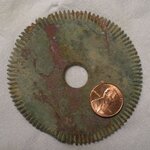TomPA
Sr. Member
- Feb 13, 2011
- 406
- 285
- Detector(s) used
- F75
AT Pro Gold
Infinium
- Primary Interest:
- Relic Hunting
I found this brass gear today at a site that dates back to the mid 1700's, but the nearby area has been inhabited since that time. Also found were several musket balls, a King George copper and a few other goodies. The gear is about as thick as a .50 cent piece and the teeth on the backside do not radiate out/in as on the side shown in the picture.
Large clock??
Large clock??



 Breezie
Breezie








